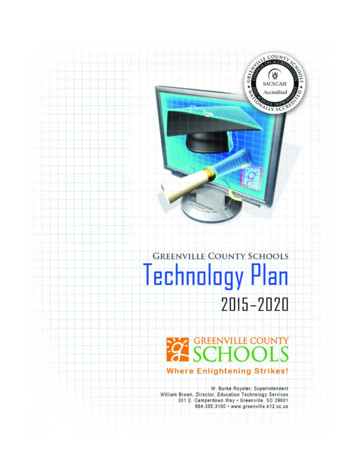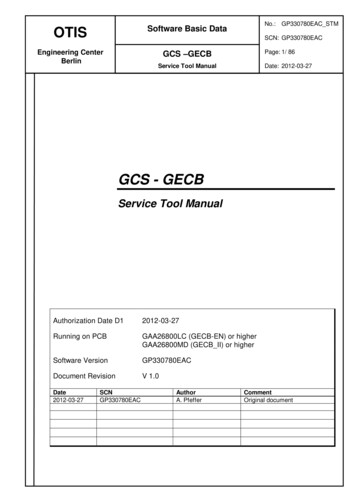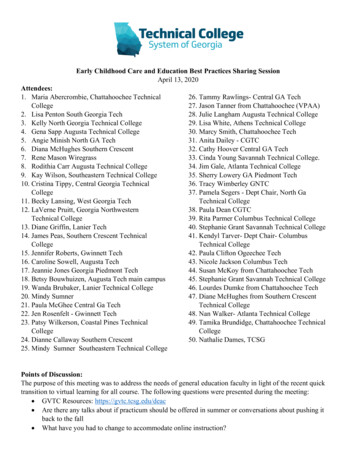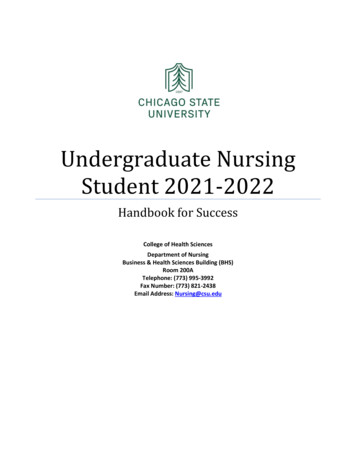
Transcription
NoticeThe development of Greenville County Schools Technology Plan: 2015‐2020, basedon Greenville County Schools Strategic Education Plan: 2013‐2018, is a result of thecontributions of the Greenville County School’s District Technology Committee. Thecommittee is comprised of a variety of stakeholders. The strategic and technologyplans are updated annually to ensure the plans remain relevant and current. Theplans are posted on the Greenville County Schools’ web site.2 PageFINAL: JAN. 2015
ApprovalsThis Technology Plan has been reviewed and submitted on behalf of the Greenville County SchoolDistrict.FOR USE BY THE SOUTH CAROLINA STATE SCHOOL DISTRICT OR LIBRARYThis plan has been reviewed and certified by the South Carolina State School District or Library.This certification will be effective for the term of this plan, but not to exceed three years.Approved by the SC State School District or Library:Date:This certification expires:3 PageFINAL: JAN. 2015
Table of ContentsDistrict ProfileExecutive SummaryDistrict Needs AssessmentDistrict Vision and Mission StatementsPlans for the Five Individual Technology DimensionsTechnology Dimension 1:Learners and their EnvironmentTechnology Dimension 2:Professional CapacityTechnology Dimension 3:Instructional CapacityTechnology Dimension 4:Community ConnectionsTechnology Dimension 5:Support CapacityInformation Technology ndix 1:Appendix 2:Appendix 3:Appendix 4:4 PageDistrict Strategic PlanAcceptable Use PolicyCOPPA Internet Permission FormErate Matching Funds BudgetFINAL: JAN. 2015
THIS PAGE INTENTIONALLY LEFT BLANK5 PageFINAL: JAN. 2015
Quick Facts (figure 1.1):45th largest school district in thenationDISTRICT PROFILELargest district in SouthCarolinaLStudent Population71,639 studentsSchool Sites:102 School Locations6 Child Development Centers1 Life Long Learning Center7 Special Centers51 Elementary Schools19 Middle Schools14 High Schools4 Career Centersong recognized as a leader in public education, GreenvilleCounty Schools is the largest school district in SouthCarolina and the 45th largest in the nation, according to thelatest publication from the National Center of EducationStatistics. Located in the northwestern part of the state, thedistrict encompasses a geographic area of approximately 800square miles and serves over 71,639 students at 102 locations.(See figure 1.1 for breakdowns)According to the U. S. Census Bureau, the population ofGreenville County is approximately 451,219 (2010). Of thisgroup, approximately 77.1% are white; 18.5% are African‐American; and 8.5% are Hispanic. Eighty five point three (85.3)percent are high school graduates (2012) and 30.9% have aBachelor’s Degree or higher (2012). Median household income is 48,438 (2012); 15.2% live below the poverty level (2012). Lastyear, 49.51% of our students qualified for free and reducedlunch. Greenville also serves 9.70% of ESOL students. Thepopulations of students whose primary language is not Englishincreases each year.Good instructional practice has always been a focus forGreenville County. Sound pedagogy and the integration oftechnology throughout the curriculum are showing resultsGCS Five Essential Goals1. Raise the Academic Challengeand Performance of Each Student2. Ensure Quality Personnel in allPositions3. Provide a School EnvironmentSupportive of Learning4. Effectively Manage and FurtherDevelop Financial Resources5. Improve Public Understandingand Support of Public Schools.6 PageGreenville County is committed to technology innovation ineducation. In 2004, the Board of Trustees approved money torefresh fifteen schools. This refresh plan has been developed andimplemented over the last several years and is now a permanentline item in the Long Range Facilities Plan. Each year fifteen ofGreenville County’s schools are refreshed with the latesttechnology. To protect the investment of the district, all teachersmust undergo technology training in compliance with theTeacher Technology proviso.Technology is a vital part of the instructional and operationalprocesses in Greenville County Schools. Teachers in GreenvilleFINAL: JAN. 2015
County are required to maintain and update websites in order to communicate effectively withparents in the digital age. The district webpage is updated daily with content to inform parentsabout activities and events taking place in the district. The operations department relies ontechnology to accomplish a number of administrative tasks. Over the last few years, more andmore paper process has moved to electronic process in order to increase efficiency andproductivity. Greenville County is committed to staying on the cutting edge of technology inorder to provide our student’s skills necessary to compete in a global, technology‐orientedsociety.7 PageFINAL: JAN. 2015
EXECUTIVE SUMMARYIn addressing the technological needs of our students, staff,and community, Greenville County Schools (GCS) hasestablished a Technology Advisory Committee (TAC) toreview, revise and/or update the District’s technology plan. Thiscommittee will seek to promote and provide equity ineducational opportunities for all students and to improvestudent achievement.This document, which is aligned to state and national standards,as well as the GCS Strategic Plan, is defined to outline ourunderstanding of how technology can assist GCS in achieving thefollowing vision:To participate in the ever‐changing global community,Greenville County Schools will give students, educators, parentsand stakeholders’ access to information, which allows for theeffective integration of technology into the learning process.We envision a community, which promotes the transition ofinformation into knowledge and the development of questioninglearners.While technology is a means of providing assistance, it is of valueonly to the extent to which student achievement and studentsupport services are enhanced. To that end, this Technology Planidentifies certain benefits and outcomes such as: Administrators can expect to be better informed aboutschool operations and district decision making. Educators can expect greater support in the developmentand implementation of instructional technology strategies. ies to participate in the educational processalong with a more efficient and equitable use of financial andhuman resources.8 PageFINAL: JAN. 2015
The GCS Technology Plan 2015‐2020 presents five GCS core technology dimensions derived fromthe guidance of Technology in American Schools: Seven Dimensions for Gauging Progress – aPolicymaker’s guide, published by the Milken Exchange on Education Technology. These coretechnology dimensions must be addressed in order to improve student achievement through theuse of technology as an integrated tool. All of the dimensions are designed to increase studentachievement through the effective integration of technology into the core curriculum.Measurable goals, objectives and strategies, action steps, funding considerations and evaluationof objectives/benchmarks are given for each core technology dimension.The five core technology dimensions and the goals set forth for these areas are as follows:Learners and Their Environment: The district and schools will use research‐proven strategies toprovide home, school, and community environments conducive to our students’ achievingtechnology literacy by the end of the eighth grade and to raise the overall level of academicachievement.Professional Capacity: The district and schools will develop ongoing and sustained professionaldevelopment programs for all educators – teachers, principals, administrators, and school librarymedia personnel.Instructional Capacity: The district and schools will use current and emerging technologies tocreate learner‐centered instructional environments that enhance academic achievement.Community Connections: The district and schools will enhance academic achievement andteacher technology proficiency through the use of technology, including assistive technology, byestablishing and maximizing community involvement and community partnerships.Support Capacity: The district and schools will develop strategies to provide the necessaryphysical infrastructure and supporting resources such as services, software and otherelectronically delivered learning materials, and print resources in order to ensure efficient andeffective uses of technology.9 PageFINAL: JAN. 2015
These five technology dimensions are regarded as synergistic parts of a single system. Each ofthe goals is followed by recommended implementation strategies and considerations that reflectaspects of the particular core dimension. Provided in this document is a cumulative list ofbenchmarks that were designed to enable the Technical Advisory Committee to validate progresson an annual basis.10 P a g eFINAL: JAN. 2015
THIS PAGE INTENTIONALLY LEFT BLANK11 P a g eFINAL: JAN. 2015
DISTRICT NEEDS ASSESSMENTT he District’s Technology Needs Assessment is based onthe Strategic Education Plan.Current Technology NeedsIncrease wide‐area network (WAN) bandwidthIncrease Internet bandwidthIncrease instructional equipment (e.g. promethean boards,laptops, desktops, tablets, etc.)Continue school refresh programExpand wireless overlay to all schools and outside venuesCurrent Technology Inventory Over 36,641 laptop and desktop systemsOver 5,941 tablet systemsOver 800 Microsoft Windows Servers5,600 Interactive White Boards10,000 voice over IP (VOIP) TelephonesRedundant data center for mission critical applicationsOver 7,000 printers and multi‐function print devicesOver 5,000 teacher and school websitesWireless overlay at all locationsVideoconference infrastructure, including an MCU with IP andISDN capabilities, as well as portable endpointsCurrent Technology Support Strategies 12 P a g eCentralized Help DeskOne computer technician for every five schools (1:3500)Network and data center support staff centrally located (1:40)Distance learning coordinatorInstructional technology facilitatorsTechnical Assistance CoordinatorsVirtual Learning CentersFINAL: JAN. 2015
THIS PAGE INTENTIONALLY LEFT BLANK13 P a g eFINAL: JAN. 2015
DISTRICT VISION AND MISSIONSTATEMENTSGreenville County Schools is dedicated to providingeducational experiences for children that are standards‐based, challenging, and rigorous; that reflect acommitment to equity; that demonstrate anappreciation of diversity; that convey high expectations forstudents and staff; and that promote continuous improvementin student achievement at all levels.The district defines its commitment to quality educationalexperiences for all students through the District’s StrategicEducation Plan. The plan defines overall district direction, guidesdistrict and school priorities, and serves as the basis of human,financial, and operational decisions. The plan was originallydeveloped in 1999 by a group of 60 individuals, including electedofficials, corporate leaders, parents, principals, teachers, districtstaff, and other community members, under the direction of theSuperintendent. The most recent plan update was conducted inthe spring of 2012.The District Strategic Education Plan articulates a clear mission,vision, and set of beliefs that serve as the plan’s foundation.MissionWe collaborate with the home and community to provideeducational experiences which prepare students for life‐longlearning and for ethical, productive participation in a democraticsociety and the global communityVisionTo be an exemplary, continuously improving educationalorganization in which all students achieve their maximumpotential through a rigorous, engaging curriculum and supportsystems that cultivate and promote their well‐being.14 P a g eFINAL: JAN. 2015
BeliefsWe believe All students can learn. Students are the center of the educational process. Students learn best in a safe, inviting environment where they are engaged in learning. Students have the responsibility to be active learners. Students must have highly competent and caring teachers, principals, and support personnel. Students should have equitable access to educational opportunities. Educational experiences empower students to communicate and collaborate effectively,solve problems competently, think critically and creatively, and act responsibly. Effective learning environments nurture the total well‐being, independence, creativity,interests, and talents of students, preparing them for post‐high school success. Our educational organization prepares students to value learning and to contribute tosociety. Our educational organization prepares students to be financially responsible andeconomically viable citizens. Curriculum and instruction should meet the needs of all students. Parent involvement and volunteer services support/enhance the teaching/learning process. Education is the shared responsibility of home, school, business and community. A comprehensive, fully funded public education is a right.The strategic education plan outlines five performance goals; goal 1 is intended as the prioritygoal, with goals 2‐5 intended to support goal 1. Goal l: Raise the academic challenge and performance of each student. Goal 2: Ensure quality personnel in all positions. Goal 3: Provide a school environment supportive of learning. Goal 4: Effectively manage and further develop necessary financial resources. Goal 5: Improve public understanding and support of public schools.15 P a g eFINAL: JAN. 2015
Each goal is supported by a series of objectives, strategies and benchmarks through whichprogress can be measured.Each school also participates in the annual strategic planning process. The unit of analysis at theschool level is the school portfolio, consisting of a demographic profile of the school, a data‐basedacademic needs assessment, identification of desired academic outcomes, an action plan andprofessional development plan for achieving outcomes, and a plan for measuring results. Schooland classroom goals are aligned to the District Strategic Education Plan goals.Directly related to the strategic planning process is the district’s comprehensive, data‐basedperformance assessment system for the superintendent and for principals (PAS‐A), teachers(PAS‐T) and Instructional Coaches (PAS‐IC). Each system has been designed to reflect thestrategic education plan goals and is based on a series of performance standards proven throughresearch to define effective school leadership.The analysis of assessment and other data is a key component of the planning process and guidesplan development at all levels. The district maintains a comprehensive profile of the system, thestudents, and the community. Data are maintained electronically and are available at both thedistrict and school levels. Student data are maintained through the state‐required StudentInformation System and include individual and group demographics; a summary of achievementoutcomes derived from various assessments, and non‐achievement data related to attendance,discipline, and drop‐outs. A comprehensive student locator system enables effectivemanagement of students’ school assignments, the district’s school‐choice program, and the bustransportation system.The Strategic Education Plan guides the allocation of all financial resources and the direction anddevelopment of the district’s long‐term and short‐range general fund budget plans.Eighty percent (80%) of the items included in the general fund budget have direct impact at theschool level in the form of funding for salaries, utilities, supplies, and maintenance. Except forsalary increases for existing district‐level staff, all additions to the annual budget have been forservices directly located in schools or in direct service to schools. The South Carolina Departmentof Education, through its In ite system, found that the district spends a significantly lowerpercentage of its budget on program management than do other districts across the state.16 P a g eFINAL: JAN. 2015
THIS PAGE INTENTIONALLY LEFT BLANK17 P a g eFINAL: JAN. 2015
PLANS FOR THE FIVE INDIVIDUALTECHNOLOGY DIMENSIONSGreenville County Schools will use research‐provenstrategies to provide home, school and communityenvironments conducive to our student’s achievingtechnological literacy by the end of the eighth grade andto raise the overall level of academic achievement.The five technology dimensions were derived from the guidanceof Technology in American Schools: Seven Dimensions forGauging Progress – a Policymaker’s Guide, published by theMilken Exchange on Education Technology (Lemke and Coughlin1998). These dimensions of technology progress – which consistsof:Learners and Their Environment: This dimension emphasizeshelping students use technology in ways that advance theirunderstanding of the content in the state curriculum standardswhile improving their real‐life problem‐solving and inquiry skills.The environment should be one of shared learning and should bedesigned to enhance student academic achievement throughscientifically based learning practices and modern technologies.Professional Capacity: This dimension emphasizes strategies todevelop ongoing and sustained professional developmentprograms for all educators—teachers, principals, administrators,and school library media personnel. Utilizing a broad definitionfor the term professional capacity, this dimension is also alignedwith the EOC action area called “Leadership and CoalitionBuilding.”Instructional Capacity: This dimension is the Executive WritingCommittee’s further refinement of the Milken dimension“Professional Competency.” South Carolina’s “InstructionalCapacity” dimension specifically targets the development ofstrategies to integrate technology into curricula and teaching andalso explores ways to promote teaching methods that are based18 P a g eFINAL: JAN. 2015
on solid and relevant scientific research. This dimension also aligns with the EOC action area“Teacher Quality.”Community Connections: This dimension emphasizes strategies for the development ofpartnerships and collaborative efforts to support technology‐related activities and to maximizecommunity involvement in education. This dimension promotes school and district partnershipswith such entities as private schools, higher education institutions, public libraries, museums,nonprofit organizations, adult literacy providers, and business and industry in ways that willincrease student achievement and teacher technology proficiency. This dimension aligns with theEOC action areas “Education for Economic Development” and “Community and Parental Supportand Involvement.”Support Capacity: This dimension seeks to combine the Milken progress dimensions “TechnologyCapacity” and “System Capacity.” South Carolina’s “Support Capacity” dimension emphasizes thedevelopment of strategies to provide the necessary physical infrastructure and supportingresources such as services, software and other electronically delivered learning materials, andprint resources in order to ensure efficient and effective uses of technology. This dimension alignswith the EOC action areas “The Governance and Structure of the System” and “Efficient Use ofResources and Accountability.”These five technology dimensions are regarded as synergistic parts of a single system. Theframework they create emphasizes a combination of critical elements that are necessary forGreenville County Schools to effectively use technology to accelerate student achievement andlearning.19 P a g eFINAL: JAN. 2015
Technology Dimension 1: Learners and their EnvironmentGreenville County Schools focuses on putting technology in the hands of students in order toprovide a learning experience that is hands‐on, relevant, and appropriate for a 21st CenturyLearning Environment.What will the technology landscape look like in a preK‐12 learning environment?At a minimum, all students will have access to a personal electronic device (PED), either theirown PED from home they bring, a device they check out, or a device shared with another student,in every learning environment throughout their preK‐12 education experience.Mobile laptop labs are just one of the technologies students have access to in all the districtschools. Each school has up to twelve laptop carts available for classroom checkout, dependingon the size of the school. Laptop labs can be used for anything from independent study to groupprojects and classroom work. The mobile labs give teachers the flexibility of taking the studentsanywhere on or off school grounds in order to provide them with a rich and relevant learningenvironment.Interactive Whiteboards are another standard that observers will notice when walking intoGreenville County Schools. The engaged learner is a successful learner. Students interact with thewhiteboards on a daily basis and quickly become active learners instead of passive learners.Students in many schools also have access to student response systems. These systems, whichwork in connection with the Interactive Whiteboards, make students a part of the learningprocess and give teachers necessary feedback to customize learning for individual students asneeded. The Interactive Whiteboards provide teachers with the tools to teach and assess withone system, making it easy to use. The ability to teach and assess as you teach can have aprofound effect on student learning. Bob Marzano, one of the authorities in classroomassessment, recently completed a study to determine the impact of using the Interactive WhiteBoard and voting systems can have in the classroom. The ultimate conclusion was that goodteachers can excel further by utilizing these tools and building on the best practices they arealready incorporating into their everyday teaching.Students have access to a variety of software for remediation around the district. GreenvilleCounty Schools subscribes to Compass Learning which is aligned with MAP scores. Scores arecompared at the end of the year to measure gains on the state assessment test. MAP, a partnerof Compass is able to prescribe students lessons based on their MAP scores.Students have access to a variety of new and emerging technologies to complete projects andproblem based lessons. Through a structured process using video cameras, podcasting, and other20 P a g eFINAL: JAN. 2015
technologies, students complete projects that incorporate real world skills such as interviewing,researching, writing, and public speaking. These technologies in the classroom foster creativity,team building, and 21st Century Skills. Learning how to utilize these technologies when studentsget out into the business world will be vital to their success. Students unable to appropriately use21st century tools to reach consumers and audiences will be at a huge disadvantage over thosewho can.21 P a g eFINAL: JAN. 2015
Technology Dimension 2: Professional CapacityGreenville County Schools is committed to ensuring that all teachers are technology proficient byproviding sustained and on‐going professional development. In order to integrate technologyinto the classroom, teachers must understand technology integration as well as be able toperform the steps necessary to use the technology required. Teachers are required to betechnology proficient through the Intel Teach to the Future Program. This program is a rigorous60 hour, graduate level course focusing on technology integration using tools readily accessibleto teachers. Once teachers receive initial certification, they must continue to keep up with theirproficiency by taking 30 hours of courses every five years. Teachers have the option as to whatcourses they take based on their experience level with technology. The goal of this initiative isthat teachers will grow in their knowledge of technology integration in the classroom.Instructional Technology is committed to releasing courses every three years in order to provideteachers with the latest best practice when it comes to integrating technology into theinstructional process. Teachers will be provided the opportunity to try, adjust, perfect technologyintegration.Instructional Technology with assistance from Education Technology Services hosts the UpstateTechnology Conference each June. This conference is provided for teachers and focuses onclassroom integration. Many of the workshops are conducted by current classroom teachers sothat attendees can get a real world perspective on classroom integration. The two dayconference offers many sessions for teachers in different strands. Teachers can focus on thetechnology they want to improve in and focus on for the following year. This conference fosterscollaboration among teachers from other schools and district around the state to meet student’sneeds in the 21st Century. The ability to collaborate with teachers outside the district providesteachers with ideas and experiences they may not be able to receive otherwise. Many of theseconnections form lasting collaboration and many classroom do projects with other teachersacross the state and country.Summer Academy is put on by Greenville County Schools during the months of June and July.Similar to the technology conference, Summer Academy offers teachers the opportunity toparticipate in technology integration workshops using technology available to teachers at theirschools. Over the last few years, many of the sessions utilize technology as the vehicle forinstructional delivery. Effective the 2013‐2014 school year, Summer Academy and the UpstateTechnology Conference have been combined as the Summer Institute.Throughout the year, teachers have access to workshops and professional development daysusing the Professional Development Registration System. Many schools host technologyTuesdays and Thursdays to foster technology integration in their school. Teachers’ workdays are22 P a g eFINAL: JAN. 2015
often used for technology workshops and hands‐on learning for teachers on various technologysoftware and tools.Transforming schools into 21st century digital learning environments requires leadership frompeople who can accept new challenges and embrace new opportunities. Now more than ever,the success of technology integration depends on leaders who can implement systemic reformthrough vision, strategic planning, allocation of resources, and monitoring. The leadership mustbe able to effectively and accurately evaluate effective technology integration and evaluatecurrent technology trends.23 P a g eFINAL: JAN. 2015
Technology Dimension 3: Instructional CapacityTeachers’ instructional capacity is increased and sustained through skill‐building professionaldevelopment for blending technology integration with instructional practice. Teachers are ableto facilitate student engagement within multiple learning platforms by implementing the SAMRmodel as a tool for technology integration. The SAMR framework consists of the followingobjectives: Redefinition – Technology allows for the creation of new tasks, previously inconceivable Modification – Technology allows for significant task redesign Augmentation – Technology acts as a direct tool substitute, with functional improvement Substitution – Technology acts as a direct tool substitute, with no functional changeAll teachers have access to Interactive White Boards. These boards allow teachers and studentsto engage in lessons that facilitate active learning with the curriculum being taught. When usedappropriately, the student’s role changes from passive learner to actively engaged learner.Consequently, the teacher’s role shifts to a model of facilitation for instructional best practice.Engaged students are more likely to be able to retain and apply concepts, information, and skillsthan students who are passively participating in classroom instruction.Additionally, teachers have access to Student Response Systems. These devices allow studentsto give teachers immediate feedback on student understanding of material being taught. Studentresponses can be downloaded and utilized to help teachers plan accordingly for instruction thatwill address gaps in student understanding and provide differentiation to meet the needs of allof their students. Student Response Systems also engage students in the process of conceptacquisition and holds them accountable for their learning.In an effort to bring the real world into the classroom and promote the global learningexperience, Greenville County employs a full time Distance Learning Coordinator to promote andexecute distance learning programs. These programs take the form of virtual field trips and guestspeakers from around the world. Students in Greenville County regularly visit speakers and guestsfrom all over the world using distance learning. International Baccalaureate schools havespecifically used Distance Learning in order to bring global experiences into the classroom.Through these programs, students can connect with other students around the world andinteract with other cultures and societies.24 P a g eFINAL: JAN. 2015
Extending the school day is important in the age of accountability. To assist teachers in reachingevery student’s needs beyond the traditional school day, Greenville County provides access toMoodle, Edmodo, and Echo as Learning Management Systems (LMS). Teachers have the abilityto put their classes on a LMS so that students can access the content anywhere, anytime,anyplace. More teachers, each year, are realizing the benefits of putting classroom content onan LMS so students can access it in the same place every time. Student organization and studyskills can be strengthen having instructional content in a centralized location to reference and aidin continual learning.Teachers utilize the SAMR model which provides a framework that serves as a guide to he
Current Technology Support Strategies Centralized Help Desk One computer technician for every five schools (1:3500) Network and data center support staff centrally located (1:40) Distance learning coordinator Instructional technology facilitators Technical Assistance Coordinators










